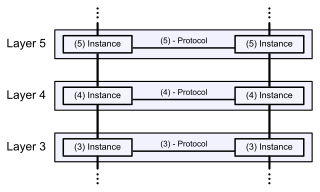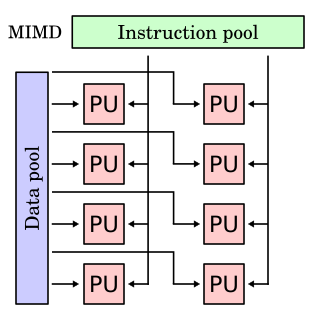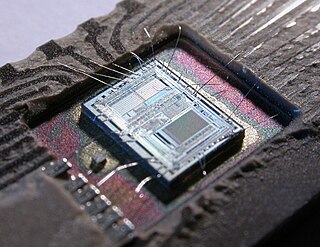Internetworking is the practice of interconnecting multiple computer networks, such that any pair of hosts in the connected networks can exchange messages irrespective of their hardware-level networking technology. The resulting system of interconnected networks are called an internetwork, or simply an internet.

The Open Systems Interconnection model is a conceptual model from the International Organization for Standardization (ISO) that "provides a common basis for the coordination of standards development for the purpose of systems interconnection." In the OSI reference model, the communications between a computing system are split into seven different abstraction layers: Physical, Data Link, Network, Transport, Session, Presentation, and Application.
Network architecture is the design of a computer network. It is a framework for the specification of a network's physical components and their functional organization and configuration, its operational principles and procedures, as well as communication protocols used.
In computer networking, peering is a voluntary interconnection of administratively separate Internet networks for the purpose of exchanging traffic between the "down-stream" users of each network. Peering is settlement-free, also known as "bill-and-keep," or "sender keeps all," meaning that neither party pays the other in association with the exchange of traffic; instead, each derives and retains revenue from its own customers.

The Internet backbone may be defined by the principal data routes between large, strategically interconnected computer networks and core routers of the Internet. These data routes are hosted by commercial, government, academic and other high-capacity network centers, as well as the Internet exchange points and network access points, that exchange Internet traffic between the countries, continents, and across the oceans. Internet service providers, often Tier 1 networks, participate in Internet backbone traffic by privately negotiated interconnection agreements, primarily governed by the principle of settlement-free peering.
In the seven-layer OSI model of computer networking, the physical layer or layer 1 is the first and lowest layer: the layer most closely associated with the physical connection between devices. The physical layer provides an electrical, mechanical, and procedural interface to the transmission medium. The shapes and properties of the electrical connectors, the frequencies to broadcast on, the line code to use and similar low-level parameters, are specified by the physical layer.
In the seven-layer OSI model of computer networking, the network layer is layer 3. The network layer is responsible for packet forwarding including routing through intermediate routers.
The data link layer, or layer 2, is the second layer of the seven-layer OSI model of computer networking. This layer is the protocol layer that transfers data between nodes on a network segment across the physical layer. The data link layer provides the functional and procedural means to transfer data between network entities and may also provide the means to detect and possibly correct errors that can occur in the physical layer.

In computing, multiple instruction, multiple data (MIMD) is a technique employed to achieve parallelism. Machines using MIMD have a number of processors that function asynchronously and independently. At any time, different processors may be executing different instructions on different pieces of data.
FCAPS is the ISO Telecommunications Management Network model and framework for network management. FCAPS is an acronym for fault, configuration, accounting, performance, security, the management categories into which the ISO model defines network management tasks. In non-billing organizations accounting is sometimes replaced with administration.
The IP Multimedia Subsystem or IP Multimedia Core Network Subsystem (IMS) is a standardised architectural framework for delivering IP multimedia services. Historically, mobile phones have provided voice call services over a circuit-switched-style network, rather than strictly over an IP packet-switched network. Alternative methods of delivering voice (VoIP) or other multimedia services have become available on smartphones, but they have not become standardized across the industry. IMS is an architectural framework that provides such standardization.

A network processor is an integrated circuit which has a feature set specifically targeted at the networking application domain.
In telecommunications, interconnection is the physical linking of a carrier's network with equipment or facilities not belonging to that network. The term may refer to a connection between a carrier's facilities and the equipment belonging to its customer, or to a connection between two or more carriers.
In telecommunications, a network-to-network interface (NNI) is an interface that specifies signaling and management functions between two networks. An NNI circuit can be used for interconnection of signalling, Internet Protocol (IP) or ATM networks.
DO-212 is a performance standard published by RTCA, Incorporated. It contains Minimum Operational Performance Standards (MOPS) for aircraft equipment required for the Automatic Dependent Surveillance (ADS) function. The supporting hardware can be a stand-alone ADS unit or alternatively, the ADS function may be installed within other on-board equipment.

A network on a chip or network-on-chip is a network-based communications subsystem on an integrated circuit ("microchip"), most typically between modules in a system on a chip (SoC). The modules on the IC are typically semiconductor IP cores schematizing various functions of the computer system, and are designed to be modular in the sense of network science. The network on chip is a router-based packet switching network between SoC modules.

An electronic circuit is composed of individual electronic components, such as resistors, transistors, capacitors, inductors and diodes, connected by conductive wires or traces through which electric current can flow. It is a type of electrical circuit and to be referred to as electronic, rather than electrical, generally at least one active component must be present. The combination of components and wires allows various simple and complex operations to be performed: signals can be amplified, computations can be performed, and data can be moved from one place to another.

An electrical grid is an interconnected network for electricity delivery from producers to consumers. Electrical grids vary in size and can cover whole countries or continents. It consists of:

A wide area synchronous grid is a three-phase electric power grid that has regional scale or greater that operates at a synchronized utility frequency and is electrically tied together during normal system conditions. Also known as synchronous zones, the most powerful is the Northern Chinese State Grid with 1,700 gigawatts (GW) of generation capacity, while the widest region served is that of the IPS/UPS system serving most countries of the former Soviet Union. Synchronous grids with ample capacity facilitate electricity trading across wide areas. In the ENTSO-E in 2008, over 350,000 megawatt hours were sold per day on the European Energy Exchange (EEX).
The Trans-European Rail network is made up of the Trans-European high-speed rail network as well as the Trans-European conventional rail network. The rail network is one of a number of the European Union's Trans-European transport networks (TEN-T).







